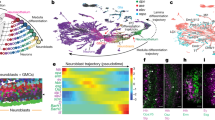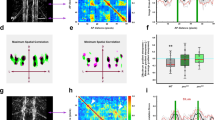Abstract
IN the newly cellularized Drosophila embryo, progress through the cell cycle is regulated at the G2–M transition1,2. We have examined cell-cycle regulation later in Drosophila development, in a group of postembryonic neuronal precursors. The S-phase precursor cells, which generate photoreceptor target neurons (lamina neurons) in the central nervous system, are not present in the absence of photoreceptor innervation3. Here we report that axons selectively approach G1-phase precursors. Without axon ingrowth, lamina precursors do not enter their final S phase and by several criteria, arrest in the preceding G1 phase. These findings provide evidence that at this stage in development the control of cell division can occur at the G1-S transition.
This is a preview of subscription content, access via your institution
Access options
Subscribe to this journal
Receive 51 print issues and online access
$199.00 per year
only $3.90 per issue
Buy this article
- Purchase on Springer Link
- Instant access to full article PDF
Prices may be subject to local taxes which are calculated during checkout
Similar content being viewed by others
References
Edgar, B. A. & O'Farrell, P. H. Cell 57, 177–187 (1989).
Edgar, B. A. & O'Farrell, P. H. Cell 62, 469–480 (1990).
Selleck, S. B. & Steller, H. Neuron 6, 83–99 (1991).
White, K. & Kankel, D. R. Devl Biol. 65, 296–321 (1978).
Hofbauer, A. & Campos-Ortega, J. A. Roux's Arch. dev. Biol. 198, 264–274 (1990).
Lehner, C. F. & O'Farrell, P. H. Cell 56, 957–968 (1989).
Whitfield, W. G. F., Gonzalez, C., Maldonado-Codina, G. & Glover, D.M. EMBO J. 9, 2563–2572 (1990).
Lehner, C. F. & O'Farrell, P. H. Cell 61, 535–547 (1990).
Lindsley, D. L. & Grell, E. H. Genetic Variations of Drosophila melanogaster (Carnegie Inst. Publ. No. 627. Washington, D.C., 1968).
Fischbach, K. F. Devl Biol. 95, 1–18 (1983).
Fischbach, K. F. & Technau, G. Devl Biol. 104, 219–239 (1984).
Baptista, C. A., Gershon, T. R. & Macagno, E. R. Nature 346, 855–858 (1990).
Ratner, N., Hong, D., Lieberman, M., Bunge, R. & Glaser, L. Proc. natn. Acad. Sci. U.S.A. 85, 6992–6996 (1988).
Truman, J. W. & Bate, M. Devl Biol. 125, 145–157 (1988).
White, K., Hurteau, T. & Punsal, P. J. comp. Neurol. 247, 430–438 (1986).
Jan, L. Y. & Jan, Y. N. Proc. natn. Acad. Sci. U.S.A. 79, 2700–2704 (1982).
Author information
Authors and Affiliations
Rights and permissions
About this article
Cite this article
Selleck, S., Gonzalez, C., Glover, D. et al. Regulation of the G1-S transition in postembryonic neuronal precursors by axon ingrowth. Nature 355, 253–255 (1992). https://doi.org/10.1038/355253a0
Received:
Accepted:
Issue Date:
DOI: https://doi.org/10.1038/355253a0
Comments
By submitting a comment you agree to abide by our Terms and Community Guidelines. If you find something abusive or that does not comply with our terms or guidelines please flag it as inappropriate.



